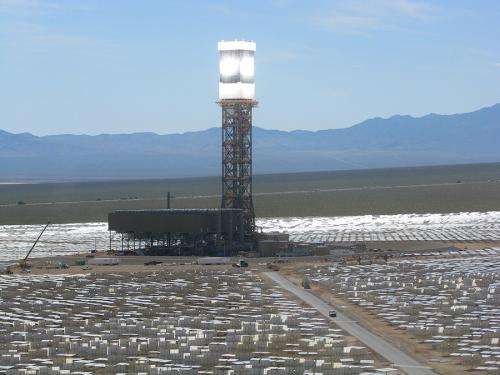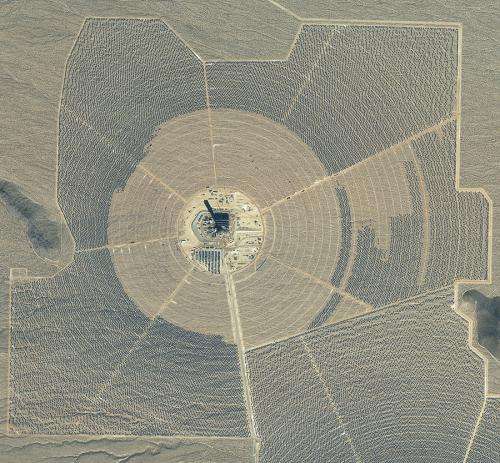September 27, 2013 weblog
Ivanpah solar plant in California starts energy feed to grid

The world's largest solar thermal plant began to feed energy into the power grid on Tuesday, considered a solar energy milestone, in a project scheduled to be fully operational by the end of the year. The system delivered its first kilowatts of power Tuesday to Pacific Gas & Electric in California, from one of three central-tower units, with the remaining two to be activated next. Power generated from Ivanpah's initial sync testing to PG&E is under a power purchase agreement for energy produced out of the plant's Unit 1 station. Power generated from the Unit 3 station is also for PG&E. Unit 2 is under an agreement with Southern California Edison. Proof-of-concept testing will also be conducted at Units 2 and 3 in the coming months.
Ivanpah Solar Electric Generating System is located in the Mojave Desert, covering some 3,500 acres of public land, The system gets its name from the Ivanpah Valley of the Mojave. The Tuesday event, said its backers, confirms the system's operational readiness. "Given the magnitude and complexity of Ivanpah, it was very important that we successfully complete this milestone showing all systems were on track," said Tom Doyle, president of NRG Solar, one of the plant's owners. NRG partners are BrightSource and Google, as well as Bechtel, responsible for engineering, procurement, construction and commissioning on the project. (BrightSource Energy is the developer; NRG Energy; BrightSource Energy and Google are the owners; and Bechtel Engineering is the contractor.) This is a 392 megawatt (377 megawatt net) plant.
A report about the project in IEEE Spectrum calls out a noteworthy feature about the system, in the context of its nature as a CSP (concentrating solar power) project, using mirrors aimed at central towers. "There are other large concentrated solar power (CSP) projects in the Middle East and Spain, but most of the growth in solar in the United States has come from photovoltaic (PV) panel projects, which have come down considerably in price in recent years," said the report.
CSP supporters say that while PV is cheap, it cannot incorporate storage using molten salts or other ideas the way that CSP can, and does not add value to the overall grid the way CSP does. CSP projects use large mirrors aimed at large central towers that create steam to drive turbines. There are three 459-foot-tall towers encircled by the large mirror sets. John Upton, writing in the environmental news site Grist, said the Ivanpah was "a startling sight" in the Mojave Desert. "Three sprawling units each contain a circular array of mirrors reflecting rays from the sun toward a 459-foot central tower."

California has a goal to get 33 percent of its electricity from renewables by 2020. Ivanpah will be reducing carbon emissions by some 400,000 tons per year over its 30-year service life. Back in 2012, Smithsonian.com took notice of the project's future impact, writing that the desert was blooming with construction crews setting up mirrors, each 70 square feet, at a rate of 500 per day across some 3,500 acres. Once fully operational, the 392 megawatt plant will generate enough electricity to power 140,000 homes annually.
More information:
spectrum.ieee.org/energywise/e … nt-syncs-to-the-grid
grist.org/business-technology/ … ed-up-in-california/
ivanpahsolar.com/
© 2013 Phys.org

















